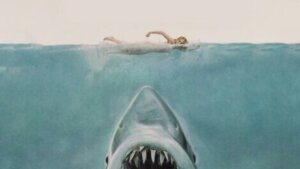Jaws: A Different Kind of Horror Movie


Written and verified by the film critic Leah Padalino
Horror movies or, at least, the kind of films that arouse fear and adrenaline in the viewer abound. Reviewing some classics of this genre, we’ve come across a movie that overwhelmed us in childhood and continues to scare us today: Jaws (Steven Spielberg, 1975).
It’s undeniable that this movie has aged particularly well, particularly bearing in mind technological advances and fears that tend to change with each new generation. In fact, Jaws appeals to a fairly rational fear compared to the myriad of supernatural threats with which we’re often confronted when we visit the movies.
We don’t mean to imply that supernatural terror doesn’t achieve its goal, but it has a tendency to be more complicated. In addition, nowadays, in the face of growing skepticism, there’s no longer really such a thing in the movies as a natural catastrophe or a plausible threat.
However, fear in the movies does originate from the plausible or probable. The kind of fear that we feel as our own and with which we can empathize. Jaws, although it has a somewhat fantastic plot, brings us closer to feelings of anguish and the primeval fear of being stalked. In fact, the monster shark is almost human and animal at the same time.
Hitchcock’s legacy
In Hitchcock’s time, technology was far removed from the possibilities it offers today. Therefore, the cinema was forced to use narrative resources that could accentuate the sensations experienced by the viewer. For instance, if you think about the first horror films, those dominated by monsters like Frankenstein, the actor’s makeup and expression were essential.
Of course, these techniques remain today, but they’re also joined by other resources that allow monsters or shadows to be generated practically from nothing. Filmmakers have had to invent absolutely everything in order to generate special effects. Everything that’s difficult to show on the screen or that poses a risk to the interpreters must be artificially recreated.
The shark
The makers of Jaws weren’t going to film with a real white shark, but with a model that was as realistic as possible. However, if the film were shot today, the model wouldn’t be necessary and new technologies would recreate a sea killer certainly as realistic, though perhaps not so lurid.
The scariest thing in Spielberg’s film happens during the first hour and a half of the film, just before the animal’s powerful teeth are shown.
Spielberg wanted to get the most out of his expensive model but, just like Stanley Kubrick with the aliens in 2001: A Space Odyssey, technical limitations worked against him.
Therefore, the team had to make use of other narrative resources in order to generate anguish in the viewer. The kind of fear that Hitchcock, the great master of suspense, would’ve invoked. In other words, they had to hit the right note at the right time.
Camera work
They achieved it by making use of what we don’t see, of the margins that the camera itself offers and, in this case, of the depths of the sea, playing with the viewer’s imagination.
The camera observes the bathers from a distance, getting closer to them while the music generates increasingly more suspense. In fact, in some scenes, the camera is submerged in order not to be a passive spectator, but to become the eyes of the shark itself stalking its prey.
There’s one scene that highlights the magic of the offscreen. It’s the scene in which the shark destroys the pier and one of the characters falls into the water. At that moment, the animal drags along the remains of the pier. Then, we see it make a turn toward the man in the water, while, at the same time, the music gradually increases in intensity.
Consequently, without even seeing the shark, the viewer is perfectly aware of what’s happening and the threat the animal poses to the character in the water.
Shark: the ineptitude of the authorities
Jaws uses the narrative image to portray a situation that, unfortunately, isn’t entirely unknown. We see how the island town of Amity, which lives purely on tourism, sees its economy in danger when a killer shark breaks into its waters in the middle of the high season.
Despite warnings from the police, the mayor prefers to look the other way and is more concerned about the economic impact on the town than the well-being of its inhabitants. The mayor is, in fact, portrayed as a rather ridiculous and inept character, who proves to be no more than an obstacle to the whole situation.
As a matter of fact, the mayor can be seen as a villain and antagonist even greater than the animal. After all, the shark is simply trying to feed itself and is responding to its survival instincts, while the mayor is acting completely selfishly, ignoring what could be a real danger to bathers.
The character of the shark hunter is also important and is a representation of the working class. The one who has no choice but to face danger.
The movie has been subject to various readings. For instance, there are those who see reminiscences of the Watergate scandal, those who criticize the scarce presence of women and non-white men, and those who point to it as a summer movie only made to please the masses.
In part, this is true. Jaws was, indeed a summer blockbuster, a movie that climaxes with the death of the monster shark. It’s a symbolic death that we might identify with other real dangers that have little or nothing to do with nature.
Who’s the real threat?
The death of the shark is a relief for the viewer, there’s no doubt about that. After all, it means the threat is over and we can breathe again. However, what about the other culprits?
The truth is that the shark, as terrifying as it may be, is just another victim. An animal in its own environment that humans, out of sheer selfishness, want to invade. Who, then, is the real threat? Who’s more dangerous, the animal or the man who values the economy more than the people in it?

A movie for everyone
It was no easy task to make a movie about the simple subject of a killer shark that was capable of holding the viewer’s attention for over two hours. In fact, for much of the movie, we find ourselves wondering how the action can possibly continue, without us becoming bored.
However, the movie overcomes these obstacles by dividing itself into two clearly differentiated halves. The first part generates tension and terror in the face of the threat while the second part immerses us in an adventure. In other words, it moves from horror to action, in fact, to the most adventurous of movies, as the three main protagonists struggle to solve the shark problem.
In the first part, we don’t see the shark yet the tension and uncertainty remain. Much of the terror remains off-screen which, although Spielberg preferred not to use too much, we greatly appreciate.
The fact that we don’t see the shark makes our minds wonder about its real dimensions. In the second part, when we finally see its mouth, it’s at the most opportune moment.
As a matter of fact, we haven’t seen the animal for so long, we no longer even expect to see it. Yet, right in the middle of the movie, its fearsome mouth both shocks and scares us. Once we’ve seen it, the movie moves on to show how the protagonists work to annihilate it and solve the problem. In this way, Spielberg ensures that at no time is our attention diverted.
A commercial film that’s stood the test of time
Obviously, the intention of the film was for it to be a commercial success, and without a doubt it was. However, it’s also fascinating to note how well it’s stood the test of time. Indeed, its music is forever etched in our minds, and every time the movie’s even mentioned, we imagine that menacing fin in the water as we hum the evocative tune.
Jaws was a commercial success on an industrial scale. Furthermore, it ultimately turned out not to be just another summer blockbuster. In fact, it still fuels the nightmares of many today.
This text is provided for informational purposes only and does not replace consultation with a professional. If in doubt, consult your specialist.








